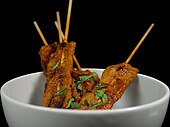Indonesian cuisine

The Indonesian cuisine is the local cuisine of Indonesia . The main food staple is rice . But manioc and yams also find access to the kitchens, because people who cannot afford rice or who are climatically disadvantaged depend on it.
Indonesia's cuisine is influenced by the cuisine of neighboring Asian countries, particularly India and China . The influence of the Dutch - from the colonial era - is still present in a large number of cakes and tarts today .
General
Indonesian cuisine differs regionally, with rice usually forming the basis. Rice was introduced around 2000 years ago. The earliest cultivation areas were Java and Kalimantan . In the eastern areas it is usually too dry for wet rice cultivation, or only moist enough in the rainy season . Traditionally, manioc and yams therefore have a considerable weight here.
In the island kingdom of Indonesia, fish and seafood are the basis of many meals. In the largest Muslim country in the world, however, pork is only consumed in areas with a Christian majority and by Hindus on the island of Bali . Rice with fish and vegetables is a common everyday dish.
Chicken is the most consumed. Ayam goreng (fried chicken) can be called a national dish. Furthermore, one finds everywhere sate , skewers with sauces on chilli or peanut-based .
Many dishes are prepared with coconut milk . In Indonesian cuisine, the seasoning paste terasi made from fermented shrimp or one of the many, sometimes very spicy sambals , which are served as a seasoning accompaniment to most dishes, is seasoned. Kecap manis , an Indonesian sweet soy sauce , is also used in many dishes .
Meat is always chopped up before preparation so that a knife does not have to be used when eating. In some places people eat with their fingers, only with the right hand, as the left hand is considered unclean.
Regional differences
Almost all areas and cities have their own specialties that are well known throughout the country. Is known z. B. nasi gudeg from Yogyakarta or ayam betutu from Bali. What is considered Indonesian cuisine internationally is Java and Sumatra cuisine in general. Some supposedly “typical Indonesian” dishes are originally recipes by the Dutch or Chinese, for example Nasi Goreng .
Sumatra's cuisine is particularly spicy. The Padang cuisine is particularly well known . Restaurants with these West Sumatric specialties can be found all over the Indonesian archipelago. The Padang restaurants have a special way of serving - the guest is offered all the dishes that are currently available. He pays for what he actually ate.
In Java , the food is a bit milder and sweeter. A specialty of East Java is rawon , a black meat soup with a special spice, keluak . One also likes to eat tempe . It is a type of fermented soybean cake.
In Sunda (West Java), the focus is on typical vegetable-based dishes that are served with a spicy sambal . Well-known are gado-gado , a salad with peanut sauce , and Oncom cooked in banana leaves .
In Bali , pork ( babi ) is also eaten, especially babi guling (from guling , "roll around, rolled up"), suckling pig with various spices. As in Java, the food is rather sweet.
The substantial soup Coto Makassar comes from Makassar and is also offered in other parts of the country.
In Manado , on the northeast tip of Sulawesi , the Minahasa also eat dog meat .
Well-known dishes

The Rijsttafel (" rice table ") introduced by the Dutch is a festive menu made up of a variety of meats , vegetables , salads , fish and curry.
Nasi goreng ( nasi , "cooked rice"; goreng , "fried") is an internationally known dish that is based on fried rice with various side dishes. However, the origin is not Indonesian. The fried rice was introduced by the Chinese. Egg side dishes are a variation of the Dutch. In Indonesia today, nasi goreng is like mi goreng , fried noodles ( bami ), more of a leftover food . Leftover rice is prepared with various ingredients and ketjap manis .
Sates are skewers of spicy beef ( sate sapi ), fish ( sate ikan ), shrimp ( sate udang ), pork ( sate babi ), chicken ( sate ayam ), goat meat ( sate kambing ) or lamb ( sate domba ). In addition, the vegetarian version with tempeh ( tempe ) is offered in many places . This includes a peanut or chili sauce .
Krupuk is now a common side dish in Indonesian and Asian cuisine, while vegetarian emping is rarely offered.
Fried dishes in the batter are also characteristic. This starts with simple banana carving as a dessert or sweet dish; This is dipped in batter, coated and fried in palm oil , known as pisang goreng . The use of palm oil is common.
literature
- Sri Owen: Indonesian Food . Pavilion, London 2015. ISBN = 978-1-910496-71-8
- Ada Henne Koene: Culinary Reconnaissance: Indonesia . In: Aramco World, January 1996, p. 18 ff.
- Alan Davidson: The Oxford Companion to Food , 2nd. ed. Oxford 2006, article Indonesia , p. 401 f.
